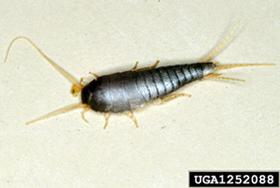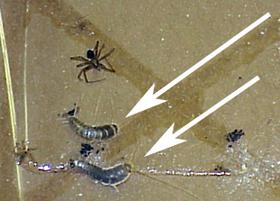Description
Silverfish and firebrats are small, wingless insects. Their bodies are flattened, somewhat "carrot-shaped", and usually covered with scales. They have two long antennae attached to the head and characteristicallly three long tail-like appendages that project from the tip of the abdomen (Figure 1).
Adult silverfish are about 1⁄2 - 3⁄4 inches in length with light gray, dark gray or silver-colored scales, depending on the species. Adult firebrats are about 1⁄2-in length and can be gray in color, but usually the scales are brown and mottled in appearance. The nymphs (immatures) look similar to the adults but are a whitish color. The flattened bodies of these insects allow them hide in very small cracks and crevices.
Biology and Behavior
Silverfish prefer cool, damp areas, and are often found in bathrooms, basements, and in bookshelves or other areas where rarely used items are stored. Firebrats favor habitats with high temperatures (90ºF and above) and humidity, such as around stoves, furnaces, fireplaces, hot-water heaters, and attics. Both silverfish and firebrats are active at night and hide in cracks and crevices during the day
A silverfish female may lay over 100 eggs during her lifetime. Eggs are laid singly or in small groups, hatching in three to six weeks. Young silverfish and firebrats resemble adults except being smaller and more white in before turning darker like the adults color in four to six weeks. Adults may live two to eight years. Firebrats lay about 50 eggs at one time in several batches. Eggs hatch in about two weeks under ideal conditions. Unlike other insects, silverfish and firebrats continue to grow and molt throughout their lives.
Feeding Activity
Silverfish and firebrats feed on many types of paper and fabric. They are particularly attracted to glazed paper or material used in book bindings, which may include starch, glues (especially on older books), or other materials. These insects also feed on carbohydrates and foods high in protein, such as dried beef and some dry pet foods.
Often the first indication of a silverfish or firebrat infestation is the evidence they leave behind. Damaged paper (Figure 2) may have notched edges or holes throughout, depending on the severity of the infestation. Book bindings that are attacked by silverfish or firebrats may have ragged edges or markings on the bindings. Silverfish and firebrats may also leave cast skins, scales, and / or feces on attacked materials.
Management of Silverfish Infestations
Silverfish populations are often small and scattered. Therefore, control efforts should be directed to those areas where infestations are present, which means taking time to look for the insects and/or the feeding evidence they leave behind (e.g., damaged paper/fabric, contaminated food, or the presence of scales, cast skins or fecal spots).
Nonchemical Management
- Sticky traps (Figure 3) placed in areas of infestation(s) will help identifiy infestation "hot spots" and may provide some control for small populations of these insects as well.
- Reduce or eliminate excess humidity that may be attracting firebrats or silverfish. Dry out rooms or other areas with excess humidity using a fan or dehumidifier. Make sure ventilation fans in bathrooms or other rooms are working properly. Repair any leaky plumbing or other sources of moisture around sinks, laundry areas, roofs, and other areas.
- Seal up cracks and crevices that may be providing shelter or allowing entry into the home.
- Eliminate access to potential food sources, including stored books, papers, fabrics, and stored food products. Reduce clutter by removing or disposing of old newspapers, books, boxes or other stored items that may serve as food sources. Items that you want to store for long periods of time should be kept in air-tight plastic bags or sealable containers. Mothballs and similar products may help keep silverfish out of storage boxes and storage containers but read package labels about possible damage to any plastic items. Always open sealed boxes containing mothballs in a open, well-aired area.
Chemical Management
Insecticide application may be necessary for severe infestations of silverfish and firebrats. Depending on the location of the infestation(s), residual spray or dust insecticides may be used. There are a few baits that contain boric acid and are used in museums and other preservation facilities. They will work well in homes when used properly. Please refer to the North Carolina Agricultural Chemicals Manual for a list of insecticides labeled for use against silverfish and firebrats. Fogging in areas such as attics rarely works because the chemical will not penetrate beneath insulation, boxes and other stored items where silverfish may be living. Liquid insecticides may be applied into cracks and crevices or as spot treatments in areas where silverfish and firebrats may hide. Dust formulations work well in areas that remain undisturbed, such as attics, basements, storage closets, or other areas not regularly frequented by people or pets. Dusts also work well in wall voids, crevices, or other such spaces, but this may require drilling small holes to get the dust where it needs to go. Carefully read and follow all label instructions.
Publication date: Jan. 31, 2017
Recommendations for the use of agricultural chemicals are included in this publication as a convenience to the reader. The use of brand names and any mention or listing of commercial products or services in this publication does not imply endorsement by NC State University or N.C. A&T State University nor discrimination against similar products or services not mentioned. Individuals who use agricultural chemicals are responsible for ensuring that the intended use complies with current regulations and conforms to the product label. Be sure to obtain current information about usage regulations and examine a current product label before applying any chemical. For assistance, contact your local N.C. Cooperative Extension county center.
N.C. Cooperative Extension prohibits discrimination and harassment regardless of age, color, disability, family and marital status, gender identity, national origin, political beliefs, race, religion, sex (including pregnancy), sexual orientation and veteran status.



